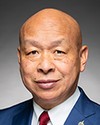Thank you, Mr. Chair.
I'm pleased to return to this committee to discuss Bill C-21 and the broader actions the government is taking to reduce gun violence.
This bill basically aims at keeping Canadians safe. It flows from the promise we made to Canadians to combat violence and crimes committed with firearms by removing weapons designed for battlefields from our streets.
Bill C-21, Mr. Chair, is the strongest gun reform legislation this country has seen in a generation. It implements a national freeze on handguns, the number one type of gun used in homicides. It addresses the alarming role of firearms in domestic violence through our red and yellow flag laws and it will raise maximum sentences against gun traffickers from 10 years to 14 years.
We're committed to getting this right and getting this legislation passed for all Canadians. To do that, we need to engage people, and that is exactly what we have been doing.
We've met hunters, firearms experts, indigenous peoples, and Canadians in rural and northern regions, to hear what they have to say and in order to get a better understanding of the role firearms play in the everyday lives of many people.
I've heard from indigenous communities that hunt to feed their families, to protect themselves and to preserve their traditions. I've met with gun owners from right across the country, and most recently in Ontario, Quebec, Nova Scotia, Yukon and Northwest Territories, where hunting is not only recreational but also something that is passed on from one generation to the next.
Of course, Mr. Chair, I have the sober responsibility of grieving with family members and communities who have been devastated by gun violence. I have consoled families in Nova Scotia, Quebec City, Montreal, Surrey and in my own hometown of Toronto. I have attended the funerals of 10 police officers. We owe it to them. Every member of this committee, every member of Parliament and every parliamentarian owes it to them to keep going.
We just marked the third anniversary of the shooting tragedy in Portapique and Truro, Nova Scotia. I joined the Prime Minister to receive the final report of the Mass Casualty Commission and to grieve with the families.
Mr. Chair, one of the recommendations to emerge from the final report called on the government to strengthen the national ban on assault-style firearms, which we put into place in 2020. It's not just the Mass Casualty Commission; it's law enforcement, survivors and victims, as well as the vast majority of Canadians, who support taking action against a type of firearm that, let's be clear, was designed to inflict the greatest number of fatalities possible in the shortest period of time.
We need to continue this work by implementing our comprehensive plan to prevent further tragedies. An intelligent policy is only one part of our comprehensive plan to protect Canadians against crimes committed with firearms. Our plan rests on three pillars.
Our plan includes strong borders to stop the flow of illegal guns, backed by a $450-million investment into border security in the last two years alone. Last year, the CBSA and RCMP seized a record number of illegal firearms at the border, but we need to continue that progress.
Another part of our plan is strong prevention through our investments in stopping crime and violence before it starts. This begins with our $250-million building safer communities fund, a program that is designed to help set up success for young people who are at greatest risk by advancing their educations and their careers so they can make positive contributions to our communities.
Initiatives like 902 Man Up in Halifax, which I have had the pleasure of visiting with, are making an incredible difference, and they are just one of the many organizations right across the country that are benefiting from this initiative.
Our national crime prevention strategy and the gun and gang violence action fund are two more examples of how we are stopping gun crime before it starts.
Finally, Mr. Chair, there are the strong gun laws and the keystone legislation that are before you right now in the form of Bill C-21.
It's purpose is to prevent another tragedy like those at the École polytechnique, Dawson College, Portapique and Truro. Canadians firmly support our prohibition on assault-style firearms, and the historic tabling of Bill C‑21.
We bring solutions, not slogans, to make sure that all Canadians can feel safe at home.
Striking the right balance to meet the goals I have outlined today while working with this Parliament is something that we remain committed to doing. Together we now have both an opportunity and a responsibility to not only pass this bill in its current form but to strengthen it.
Mr. Chair, I look forward to supporting amendments that will address the assault-style rifle ban, as the Mass Casualty Commission's final report called on us to do, along with other priorities that deal with ghost guns and, indeed, the responsibilities of manufacturers to play their role in keeping our communities safe.
Mr. Chair, in conclusion, Canadians are counting on us to do this work responsibly, based on facts, not fear, and I hope all of my colleagues will contribute to a constructive dialogue today
I now look forward to your questions.













